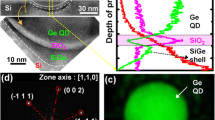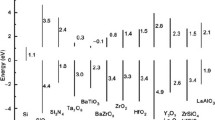Abstract
In 1987, silicon-based metal-oxide-semiconductor field-effect transistors (MOSFETs) with gate oxide film thickness of 3.3 nm were shown to operate at liquid nitrogen temperature.[1] As a result of continuing progress in microfabrication technology since that time, MOSFETs with gate oxide film thickness of 1.5 nm were shown to operate at room temperature[2] and the fabrication of 1 Gbit dynamic random access memory (DRAM) was reported.[3,4] The mass production of 1 Gbit DRAM using MOSFETs with gate oxide film thickness of about 5 nm must be realized at the beginning of the next century. In this case the thickness of one-molecular-layer of SiO2 corresponds to 6% of gate oxide film thickness. Therefore, it is necessary to control the formation of SiO2 and SiO2/Si interface on an atomic scale by improving the cleanliness and flatness of Si surfaces before the oxidation The control of oxide formation on an atomic scale is important for the formation of high quality SiO2/Si interfaces for future metal-oxidesemiconductor (MOS) technology.[5]
Access this chapter
Tax calculation will be finalised at checkout
Purchases are for personal use only
Preview
Unable to display preview. Download preview PDF.
Similar content being viewed by others
References
Sai-Halasz, G. A., Wordeman, M. R., Kern, D. P., Ganin, E., Rishton, S., Zichennan, D. S., Schmid, H., Polcari, M. R., Ng, H. Y., Restle, P. J., Chang, T. H. and Dennard, R. H. (1987) Design and Experimental Technology for 0.1- P m Gate-Length Low-Temperature Operation FETs, IEEE Electron. Device Lett. 8, 463–466.
Sasaki Momose, H., Ono, M., Yoshitomi, T., Ohguro, T., Nakamura, S., Saito, M. and Iwai, H. (1994) Tunneling gate oxide approach to ultra-high current drive in small-geometry MOSFETs, IEDM 94, pp. 593–596.
Horiguchi, M., Sakata, T., Sekiguchi, T., Ueda, S., Tanaka, H., Yamasaki, E., Nakagome, Y., Aoki, M., Kaga, T., Ohkura, M., Nagai, R., Murai, F., Tanaka, T., Iijima, S., Yokoyama, N., Gotoh, Y., Shoji, K., Kisu, T., Yamashita, H., Nishida, T. and Takeda, E. (1995) An experimental 220 MHz 1Gb DRAM, Int.. Solid-State Circuits Conf Digest of Technical Papers pp. 252–253.
Sugibayashi, T., Naritake, I., Utsugi, S., Shibahara, K., Oikawa, R., Mori, H., Iwao, S., Murotani, T., Koyama, K., Fukazawa, S., Irani, T., Kasama, K., Okuda, T., Ohya, S. and Ogawa, M. (1995) A 1Gb DRAM for file applications, IEEE Int. Solid-State Circuits Conf Digest of Technical Papers pp. 254–255.
Hattori, T. (1995) Chemical structures of the SiO2/Si interface, Critical Rev. Solid State Mat. Sci . 20, 339–382.
Takahagi, T., Nagai, I., Ishitani, A. and Kuroda H. (1988) The formation of hydrogen passivated silicon single-crystal surfaces using ultraviolet cleaning and HF etching, J. Appl. Phys . 64, 3516–3521.
Sakuraba, M., Murota, J. and Ono, S. (1994) Stability of the dimer structure formed on Si(100) by ultraclean low-pressure chemical-vapor deposition, J. Appl. Phys. 75 3701–3703.
Higashi, G. S., Becker, R. S., Chabal, Y. J. and Becker, A. J. (1991) Comparison of Si(111) surfaces prepared using aqueous solutions of NH4F versus HF, Appl. Phys. Lett . 58 1656–1658.
Watanabe, S., Nakayama, N. and Ito, T. (1991) Homogeneous hydrogen-terminated Si(111) surface formed using aqueous HF solution and water, Appl. Phys. Lett . 59, 1458–1460.
Aoyama, T., Goto, K., Yamazaki, T. and Ito, T. (1996) Silicon (001) surface after annealing in hydrogen ambient, J. Vac. Sci. Technol . A14 2909–2915.
Bender, H., Verhaverbeke, S., Caymax, M., Vatel, O. and Hynes, M. M. (1994) Surface reconstruction of hydrogen annealed (100) silicon, J. Appl. Phys . 75 1207–1209.
Ohmi, T., Morita, M., Teramoto, A., Makihara, K. and Tseng, K. S. (1992) Very thin oxide film on a silicon surface by ultraclean oxidation, Appl. Phys. Lett . 60, 2126–2128.
Gelius, U., Wannberg, B., Baltzer, P., Fellner-Feldegg, H., Carlsson, G., Johansson, C. -G., Larsson, J., Munger, P. and Vergerfos, G. (1990) A new ESCA instrument with improved surface sensitivity, fast imaging properties and excellent energy resolution, J. Electron Spectrosc. Relat. Phenom . 52 747–785.
Guthner, P. (1996) Simultaneous imaging of Si(I11)7 X 7 with atomic resolution in scanning tunneling microscopy, atomic force microscopy, and atomic force microscopy noncontact mode, J. Vac. Sci. & Technol. B14 2428–2431.
Nohira, H., Tamura, Y., Ogawa, H. and Hattori, T. (1992) Initial stage of SiO2/Si interface formation on Si(111) surface, IEICETrans. Electron . E75-C, 757–763.
Ohishi, K. and Hattori, T. (1994) Periodic changes in SiO2/Si(111) interface structures with progress of thennal oxidation, Jpn. J. Appl. Phys . 33 L675–L678.
Hollinger, G. and Himpsel, F. J. (1984) Probing the transition layer at the SiO2-Si interface using core level photoemission, Appl. Phys. Lett . 44 93–95.
Aiba, T., Yamauchi, K., Shimizu, Y., Tate, N., Katayama, M. and Hattori, T. (1995) Initial stage of oxidation of hydrogen-terminated Si(100)-2 X 1 surface, Jpn. J. Appl. Phys . 34 707–711.
Ohishi, K. and Hattori, T. (unpublished).
Omura, A., Sekikawa, H. and Hattori, T. (1997) Lateral size of atomically flat oxidized region on Si(111) surface, Appl. Surf Sci. 117/118 127–130.
Lyo, I. -W., Avouris, Ph., Schubert, B. and Hoffmann, R. (1990) Elucidation of the initial stage of the oxidation of Si(111) using scanning tunneling microscopy and spectroscopy, J. Phys. Chem. 94 4400–4403.
Ohashi, M. and Hattori, T. (1997) Correlation between surface microroughness of silicon oxide film and Si02/Si interface structure, Jpn. J. Appl. Phys. 36, L397–L399.
Hattori, T., Fujimura, M., Yagi, T. and Ohashi, M. (1997) Periodic changes in surface microroughness with progress of thermal oxidation of silicon, reported at 6th Int. Cont. on Formation of Semiconductor Interfaces, Cardiff.
Yasaka, Y., Uenaga, S., Yasutake, H., Takakura, M., Miyazaki, S. and Hirose, M. (1992) Cleaning and oxidation of heavily doped Si surfaces, Mater. Res. Soc. Symp. Proc. 259, 385–390.
Niwa, M., Kouzaki, T., Okada, K., Udagawa, M. and Sinclair, R. (1993) Atomic-order planarization of ultrathin Si02/Si(001) interfaces, Jpn. J. Appl. Phys. 33 388–394.
Pantelides, S. T. and Long, M. (1978) Continuous-random-network models for the Si-Si02 interface, The Physics of Si0 2 and its Interface, S. T. Pantelides, Ed., Pergamon, New York, pp. 339–343.
Herman, F., Batra, I.P. and Kasowski, R.V. (1978) Electronic structure of a model Si-Si02 interface, The Physics of Si0 2 and its Interface, S. T. Pantelides, Ed., Pergamon, New York, pp. 333–338.
Banaszak Holl, M. M., Lee, S. and McFeely, F. R. (1994) Core-level photoemission and the structure of the Si/Si02 interface: A reappraisal, App!. Phys. Lett. 65 1097–1099.
Pasquarello, A., Hybensen, M. S. and Car, R. (1995) Si 2p core-level shifts at the Si(001)-Si02 interface: a first-principles study, Phys. Rev. Leu. 74 1024–1027.
Williams, R. (1965) Photoemission of electrons from silicon into silicon dioxide, Phys. Rev. A140, 569–575.
Ohmi, T., Morita, M. and Hattori, T. (1988) Defects and impurities in SiO2 interface for oxides prepared using superclean methods, The Physics a nd Chemistry of SiO 2 and the Si-Si0 2 Interface, Plenum Press, New York, pp. 413–419.
Yoshida, T., Imafuku, D., Alay, J. L., Miyazaki, S. and Hirose, M. (1995) Quantitative analysis of tunneling current through ultrathin gate oxides, Jpn. J. Appl. Phys. 34 L903–L906.
Heimlich, C., Kubota, M., Murata, Y., Hattori, T., Morita, M. and Ohmi, T. (1990) ARUPS study of an impurity-induced stabilization of Si02 on Si(100), Vacuum 41 793–795.
Nohira, H. and Hattori, T. (1997) Si02 valence band near the Si02/Si(111) interface, App!. Surf. Sci. 117/ 118 119–122.
Ishikawa, K., Ogawa, H., Oshida, S., Suzuki, K. and Fujimura, S. (1995) Thickness-deconvolved structural properties of thermally grown silicon dioxide film, Ext. Abstr. of Int. Conf. on Solid State Devices and Materials, Osaka, pp. 500–502.
Sugita, Y., Awaji, N. and Watanabe, S. (1996) Transient oxide layer at a thermally grown SiO2/Si interface, interpreted based on local vibration and X-ray reflectivity, Ext. Abstr. of Intern. Conf. on Solid State Devices and Materials, Yokohama, pp. 380–382.
May, J. L., Fukuda, M., Bjorkman, C. H., Nakagawa, K., Sasaki, S., Yokoyama, S. and Hirose, M. (1995) Determination of valence band alignment at ultrathin Si02/Si interface by high-resolution X-ray photoelectron spectroscopy, Jpn. J. App!. Phys. 34 L653–L656.
Alay, J. L., Fukuda, M., Nakagawa, K., Yokoyama, S. and Hirose, M. (1995) The valence band alignment at ultra-thin SiO2/Si(100) interfaces determined by high-resolution X-ray photoelectron spectroscopy, Ext. Abstr. of Intern. Conf. on Solid State Devices and Materials, Osaka, pp. 28–30.
Author information
Authors and Affiliations
Editor information
Editors and Affiliations
Rights and permissions
Copyright information
© 1998 Springer Science+Business Media Dordrecht
About this chapter
Cite this chapter
Hattori, T. (1998). Surface, Interface and Valence Band of Ultra-Thin Silicon Oxides. In: Garfunkel, E., Gusev, E., Vul’, A. (eds) Fundamental Aspects of Ultrathin Dielectrics on Si-based Devices. NATO Science Series, vol 47. Springer, Dordrecht. https://doi.org/10.1007/978-94-011-5008-8_17
Download citation
DOI: https://doi.org/10.1007/978-94-011-5008-8_17
Publisher Name: Springer, Dordrecht
Print ISBN: 978-0-7923-5008-8
Online ISBN: 978-94-011-5008-8
eBook Packages: Springer Book Archive




